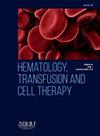Lower doses of dacarbazine (modified BEACODD) as a safer strategy with equal effectiveness in an intensive treatment protocol of Hodgkin's lymphoma: a preliminary retrospective analysis of a single public center in Brazil
IF 1.8
Q3 HEMATOLOGY
引用次数: 0
Abstract
The German Hodgkin Study Group developed the escalated BEACOPP (bleomycin, etoposide, doxorubicin, cyclophosphamide, vincristine, procarbazine, and prednisone) protocol as a treatment strategy for advanced-stage Hodgkin's lymphoma. In Brazil, as well as in other countries, procarbazine has been replaced with dacarbazine due to the limited availability of procarbazine. The Hematology Center at Irmandade da Santa Casa de Misericórdia in São Paulo adopted and modified the escalated BEACOPP protocol, substituting prednisone with dexamethasone and incorporating two different doses of dacarbazine: 375 mg/m2/day on Day 8 or the original dose of 250 mg/m2/day on Days 2 and 3. This adjustment was made in response to the anticipated toxicity profile. This study aimed to compare the two different doses in the protocols (375 mg/m2/cycle versus 500 mg/m2/cycle) administered to patients with advanced Hodgkin's lymphoma in similar periods. This retrospective study analyzed the data of 31 patients at a single center in Brazil from 2019 to 2021. Seventeen of the 31 patients received 500 mg/m2/cycle (500 Group), while 14 received 375 mg/m2/cycle (375 Group). At the end of the protocol, 71% of the patients in the 375 Group and 76% in the 500 Group achieved complete remission. On analyzing the number of cycles that patients presented with febrile neutropenia, the 500 Group had three times more events (17.9%) than the 375 Group (6.09% - p-value = 0.04). In the 500 Group, 47.1% needed to change the protocol to ABVD (doxorubicin hydrochloride, bleomycin sulfate, vinblastine sulfate, and dacarbazine) due to toxicity. In this limited cohort from a single public center in Brazil, the use of 375 mg/m2 of dacarbazine per cycle of the modified escalated BEACOPP protocol emerged as a safer strategy, maintaining treatment efficacy without compromising response in patients with advanced Hodgkin's lymphoma.
在霍奇金淋巴瘤强化治疗方案中,低剂量达卡巴嗪(改良 BEACODD)是一种更安全且疗效相同的策略:对巴西一家公立中心的初步回顾性分析。
德国霍奇金研究小组制定了升级版 BEACOPP(博来霉素、依托泊苷、多柔比星、环磷酰胺、长春新碱、丙卡巴嗪和泼尼松)方案,作为晚期霍奇金淋巴瘤的治疗策略。在巴西和其他国家,由于丙卡巴嗪的供应有限,丙卡巴嗪已被达卡巴嗪取代。圣保罗的圣母玛利亚医院(Irmandade da Santa Casa de Misericórdia)血液学中心采用并修改了升级版 BEACOPP 方案,用地塞米松取代了泼尼松,并加入了两种不同剂量的达卡巴嗪:第 8 天为 375 毫克/平方米/天,第 2 天和第 3 天为原来的 250 毫克/平方米/天。这一调整是根据预期的毒性情况做出的。这项研究旨在比较两种不同剂量的方案(375 毫克/平方米/周期与 500 毫克/平方米/周期)在相似时期对晚期霍奇金淋巴瘤患者的治疗效果。这项回顾性研究分析了巴西一家中心在2019年至2021年期间31名患者的数据。31 名患者中有 17 人接受了 500 毫克/平方米/周期(500 组)治疗,14 人接受了 375 毫克/平方米/周期(375 组)治疗。在方案结束时,375 组和 500 组分别有 71% 和 76% 的患者实现了完全缓解。在分析患者出现发热性中性粒细胞减少症的周期数时,500 组(17.9%)是 375 组(6.09% - P 值 = 0.04)的三倍。在 500 组中,47.1% 的患者因毒性而需要将治疗方案改为 ABVD(盐酸多柔比星、硫酸博来霉素、硫酸长春碱和达卡巴嗪)。在这个来自巴西一家公立中心的有限队列中,在改良升级BEACOPP方案中,每个周期使用375毫克/平方米达卡巴嗪是一种更安全的策略,既能维持晚期霍奇金淋巴瘤患者的疗效,又不影响其反应。
本文章由计算机程序翻译,如有差异,请以英文原文为准。
求助全文
约1分钟内获得全文
求助全文
来源期刊

Hematology, Transfusion and Cell Therapy
Multiple-
CiteScore
2.40
自引率
4.80%
发文量
1419
审稿时长
30 weeks
 求助内容:
求助内容: 应助结果提醒方式:
应助结果提醒方式:


